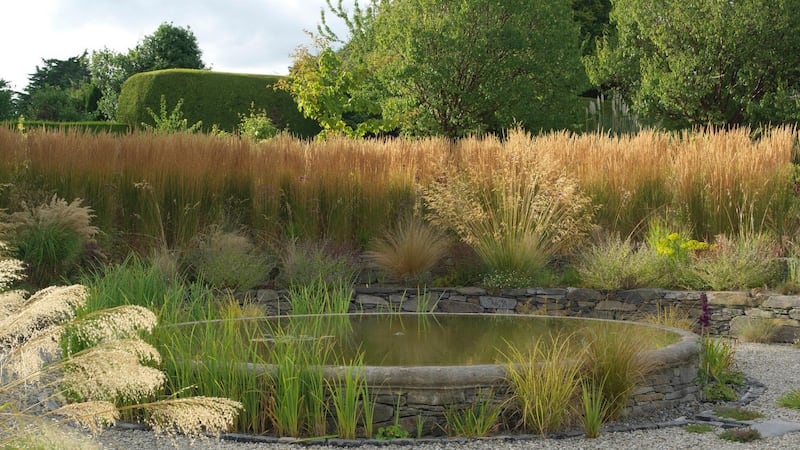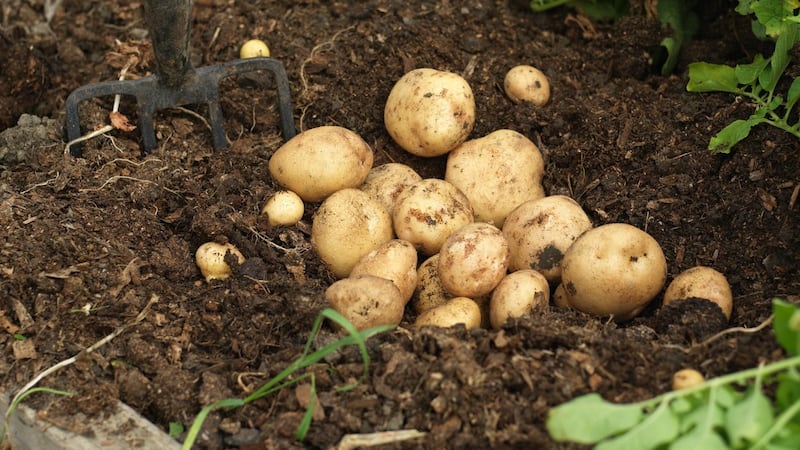If I had to single out a particular group of plants that shouts 21st-century gardening, it would be ornamental grasses. Just think of all those dreamy noughties images of Piet Oudolf-inspired prairie-style plantings filled with gauzy drifts of pennisetums and panicums back-lit by the burnished evening light of a late summer’s day, their gossamer-light inflorescences shimmering like . . . Okay, I’ll stop right there, but you know what I’m talking about. Seduced by all that beauty, most of us fell for it hook, line and sinker while temporarily forgetting the small matter of our cool, damp Irish climate and its unsuitability for certain kinds of heat-loving, light-loving species. Cue disappointment followed by disenchantment with the result that many Irish gardeners made the mistake of giving up on ornamental grasses altogether.
I say ‘mistake’ because no other group of plants has the same ability to add movement, life and texture to a planting scheme. Used well, ornamental grasses are to a garden what yeast is to dough, what bubbles are to champagne, what helium is to a party balloon, lifting and leavening it so that the planting seems to float. In a town garden, they provide the perfect antidote to an excess of hard surfaces, while always looking elegant and contemporary. In a country garden, they have a unique ability to soften and blur its boundaries within the wider wilder, landscape. In short, rather than giving up on them, we should refocus our efforts on the kinds of ornamental grasses that best suit the Irish climate and our gardens’ growing conditions.
Many of these are what are termed cool-season grasses; examples include species/varieties of Stipa, Deschampsia, Chionochloa, Briza, Molinia and Luzulaa. All of these come into growth and flower early in the year and are tolerant of our cool, damp springs and summers. Many are also impressively hardy, disease and pest-resistant, have an exceptionally long season of interest and are tolerant of a surprisingly wide range of soils and light conditions, making them a great choice for most Irish gardens. The evergreen Chionochloa rubra, for example, is a magnificently ornamental cool-season species, happy in a dampish soil in full sun or light shade but also very drought-tolerant. Commonly known as red tussock grass on account of its slender, arching, copper-coloured leaves, it's a favourite of mine as well as of the Wicklow-based gardener and nursery-owner June Blake, who recommends it highly for container-growing because of its all-year-round good looks.


Another of Blake's favourites is its close relative, Chionochloa conspicua, commonly known as the plumed tussock grass, which she grows in her garden's mixed borders alongside ornamental perennials. A large, evergreen species with silver-white flower plumes that appear from August to October, it looks a little like a miniature Pampas grass, but without any of the latter's innate naffness or dubious 'swinger' connotations (enough said).
Irish climate
Both of these species of Chionochloa are available from Dublin-based Mount Venus Nursery (mountvenusnursery.com), which specialises in a wide range of ornamental grasses suited to the Irish climate. Its owners Oliver and Liat Schurmann also use a very diverse selection of ornamental grasses in their garden design practice, deftly knitting them into the planting in a way that's both visually beautiful and ecologically appropriate. Amongst their favourites is the perennial mountain grass (Oryzopsis miliacea), a medium-sized evergreen, sun-loving cool-season grass with pretty, arching flower-heads from spring to autumn. Another is the evergreen, shade-loving, snowy woodrush (Luzula nivea), which is happy in a cool moist soil, making it an excellent ornamental grass to intermingle with woodland species.
Of course, no discussion of cool-season grasses would be complete without a mention of the popular, ultra-versatile giant oat grass (Stipa gigantea) a tussock-forming, sun-loving evergreen species with tall, impressively long-lasting golden flower-heads prized for its ability to give airy height to a planting scheme. Its much smaller relative, the similarly versatile pony-tails grass (Stipa tenuissima), is another staple of modern garden design with good reason; its floaty, wispy leaves and flowers look at home in almost every kind of garden while it has also has the uncanny knack of gluing a planting scheme together. Other classic cool-season grasses include Calamagrostis 'Overdam' and the similar C 'Karl Foerster', both of which do very well in a sunny, well-drained spot, their strongly vertical growth habit making them enduring favourites with garden-designers.
In contrast to all of the above, warm-season grasses are typically deciduous, late-flowering and need a free-draining soil as well as high heat and excellent light levels to flourish. Given a cool, damp Irish summer, they can sulk and grow slowly, sometimes not even getting to the point of blooming before summer’s end. In other words, without producing those dreamy, gauzy drifts of shimmering inflorescences that were the very reason you planted them in the first place.
Examples of warm-season grasses include Panicum, Pennisetum, Miscanthus and Sporobolus, although it's fair to say many species/varieties of these do merit inclusion in an Irish garden when given the right growing conditions. For example, prairie dropseed (Sporobolus heterolepsis) is a favourite of the Schurmanns, who prize it for its long season of interest and its delicate flower-heads, which appear from spring until autumn and are covered with glittering beads of water after rain or a heavy dew.
Some varieties of Miscanthus are also well worth growing for their handsome ornamental foliage alone while others – Oliver Schurmann recommends Miscanthus 'Malepartus', Miscanthus 'Graziella' and the compact Miscanthus 'Yakushima Dwarf' – will reliably flower in the right growing conditions. The trick with any of these sun-loving, warm-season grasses is to avoid giving them an overly fertile soil and to provide them with shelter from cold winds. Last but definitely not least, avoid squeezing them into a cramped spot where they'll be competing with other tall plants for light and space. Instead, let them shine like the superstars they really are.
This week in the garden
As long as the ground isn’t frozen or waterlogged, March is a good time to plant lily bulbs. These pretty, summer-flowering plants like a rich but free-draining soil and a sheltered position in light shade, so add some well-rotted compost or manure to the soil before planting, If you have any leaf mould, then add a little of this too. If it’s heavy clay or inclined to be poorly drained, a layer of sharp grit at the bottom of the planting hole will help. Plant the bulbs to a depth of 10-15cm (pointed end up) then cover with soil. If you’re growing the bulbs in containers, make sure they are reasonably large and deep. Protect the emerging plants from slugs and watch out for lily beetles.
Mid to late March is traditionally the time to plant first-early varieties of potatoes in Ireland such as 'Duke of York, 'Lady Christl' and 'Casablanca'. These fast-cropping varieties grow much more quickly than maincrop varieties so usually avoid damage from blight. They also need slightly less space than maincrop varieties, so plant them in ridges/rows to a depth of 10-15cm, allowing 25cm between plants and 50cm between each ridge/row. All varieties of potato like a rich but well-drained soil in full sun.
Dates for your diary
Tuesday March 27th (8pm), The Parade Tower, Kilkenny Castle, Kilkenny, The Story of the Lafcadio Hearn Garden in Waterford, a talk by Agnes Aylward as part of the annual Garden Talks Series 2018 organised by OPW Kilkenny Castle and garden writer Shirley Lanigan, see kilkennycastle.ie for details.
Easter Sunday, April 1st, and Easter Monday, April 2nd, Farmleigh Estate, Phoenix Park, Dublin 15, the Irish Specialist Nurseries Association 2nd Plant Fair of 2018 with stands/ stalls from a variety of specialist Irish growers and suppliers, see irishspecialistnurseriesassociation.com.
Saturday, April 7th (9am-5pm) , Citywest Hotel, Citywest, Dublin, Mr Middleton's Annual Spring Garden Masterclass with guest speakers Helen Dillon, TJ Maher of Patthana Gardens, Mike Sokolowski of David Austin Roses and Thomas Quearney (mrmiddleton.com , tel: 01 8603674)), €80, pre-booking essential.













